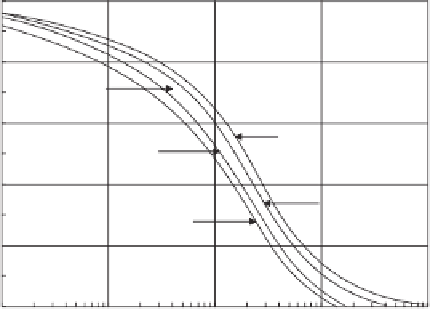Environmental Engineering Reference
In-Depth Information
divergence of the flow rate as described by the appropriate
flow laws.
0.0
0.1
0.2
0.3
0.4
0.5
0.6
0.7
0.8
0.9
1.0
C
w
ranging from 0.0 to 5.0
C
a
ranging from 0.0 to 1.0
C
w
= 2.0
C
a
< 0.1
16.6.1 Stress, Water, and Air Coupling
for Three-Dimensional Consolidation
Following is a three-dimensional formulation of coupled
consolidation of an unsaturated soil. The formulation is sim-
ilar to the derivation presented by Biot (1941). Some of the
terms have been changed for consistency with more recent
terminology used in unsaturated soils. The coupled formula-
tion for three-dimensional consolidation is presented for the
case where the air phase is continuous (Dakshanamurthy et
al., 1984). The constitutive relations for the soil structure,
the water phase, and the air phase are required when writing
the equilibrium and continuity equations. These constitutive
relations are first summarized in their elasticity forms prior
to formulating the coupled consolidation equations.
C
w
= 5.0
C
a
< 0.1
C
w
= 1.0
C
a
< 0.1
C
w
= 4.0
C
a
< 0.1
C
w
< 1.0
All
C
a
values
0.001
0.01
0.1
1
10
Time factor (water phase),
T
w
Figure 16.18
Dimensionless time factor versus degree of consol-
idation curves for water phase.
16.6.2 Constitutive Relations for Unsaturated Soil
The stress state and deformation state variables can be linked
by suitable constitutive relations that incorporate soil prop-
erties in the form of coefficients. There are three available
constitutive relations for an unsaturated soil, namely, one
for the soil structure, one for the water phase, and one for
the air phase (see Chapter 13).
0.0
C
a
ranging from 0.0 to 1.0
C
w
ranging from 0.0 to 5.0
0.1
0.2
0.3
C
a
< 0.01
All
C
w
values
0.4
0.5
0.6
C
a
= 0.4
C
w
< 1.0
C
a
= 0.1
C
w
< 1.0
16.6.3 Soil Structure Constitutive Relationship
The constitutive equation for the soil structure is presented
assuming that the soil behaves as an isotropic, linear elastic
material. The soil structure constitutive relationship written
for normal strains in the
x
-,
y
-, and
z
-directions can be
written in the following incremental form:
0.7
0.8
C
a
= 0.2
C
w
< 1.0
0.9
1.0
0.001
0.01
0.1
1.0
Time factor (air phase),
T
a
Figure 16.19
Dimensionless time factor versus degree of consol-
idation curves for air phase.
d(σ
x
−
u
a
)
μ
E
d(σ
y
+
d(u
a
−
u
w
)
dε
x
=
−
σ
z
−
2
u
a
)
+
E
H
(16.47)
A rigorous formulation of two- and three-dimensional
consolidation requires that the continuity equation for water
and air flow be coupled with the equilibrium equations. The
resulting equations need to then be solved simultaneously.
Biot (1941) formulated the coupled consolidation process
for a special case of an unsaturated soil. The derivation
was based on the assumption that occluded bubbles of air
existed in the pore fluid during the consolidation process.
The coupled formulation of consolidation was then solved
for the one-dimensional case.
The following sections present the equations for the cou-
pled theory of consolidation for an unsaturated soil. Con-
sider a referential element of unsaturated soil subjected to
two-dimensional unsteady-state air and water flow, as shown
in Fig. 16.20. The partial differential flow equations for the
air phase and the water phase can be derived by equating the
time derivative of the relevant constitutive equations to the
d(σ
y
−
u
a
)
μ
E
d(σ
x
+
d(u
a
−
u
w
)
dε
y
=
−
σ
z
−
2
u
a
)
+
E
H
(16.48)
d(σ
z
−
u
a
)
μ
E
d(σ
x
+
d(u
a
−
u
w
)
dε
z
=
−
σ
y
−
2
u
a
)
+
H
(16.49)
The constitutive equations for shear deformations are
E
dτ
xy
G
dγ
xy
=
(16.50)
dτ
yz
G
dγ
yz
=
(16.51)
dτ
zx
G
dγ
zx
=
(16.52)
where:
ε
x
=
normal strain in the
x-
direction,
ε
y
=
normal strain in the
y-
direction,



























Search WWH ::

Custom Search